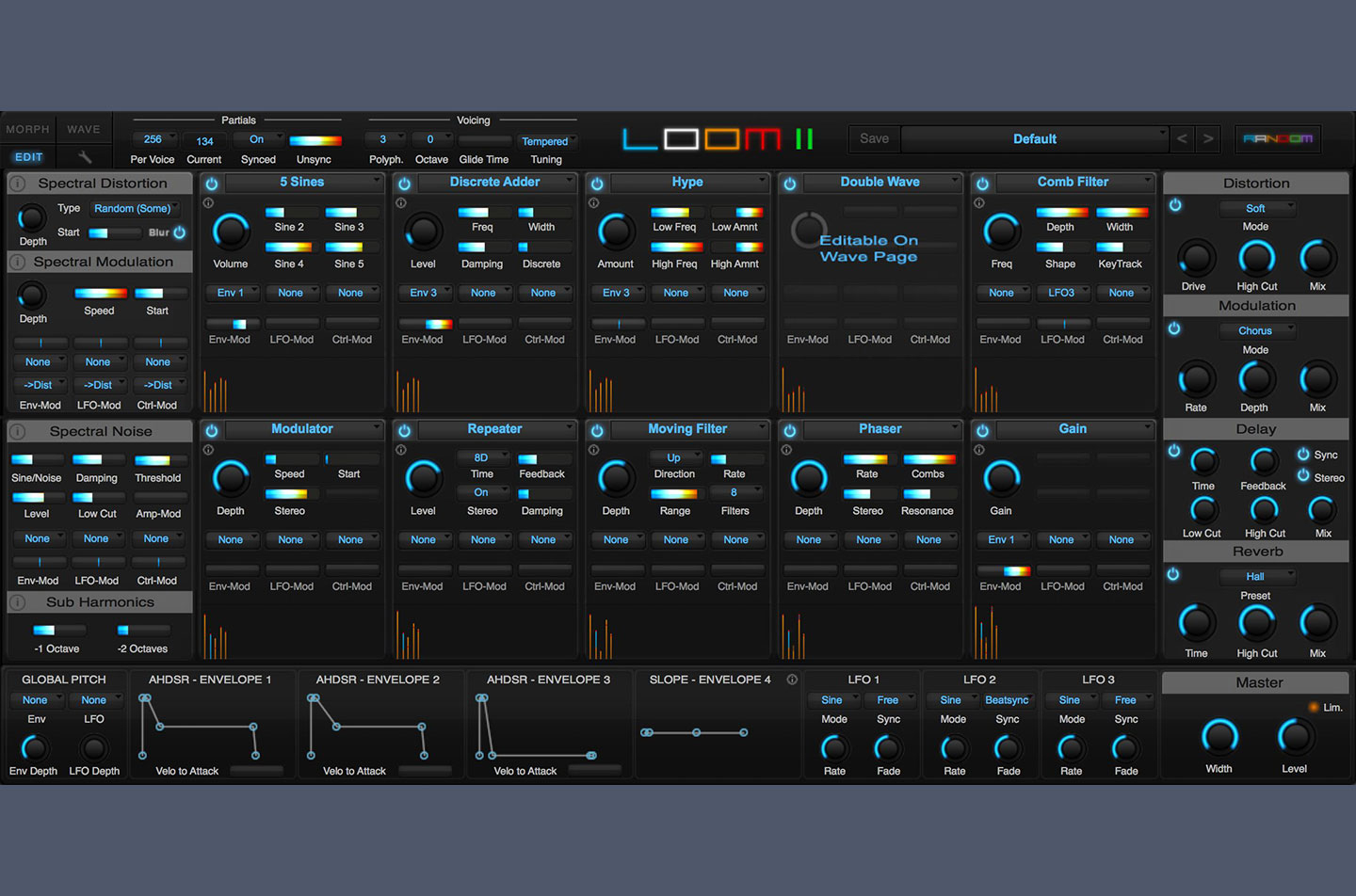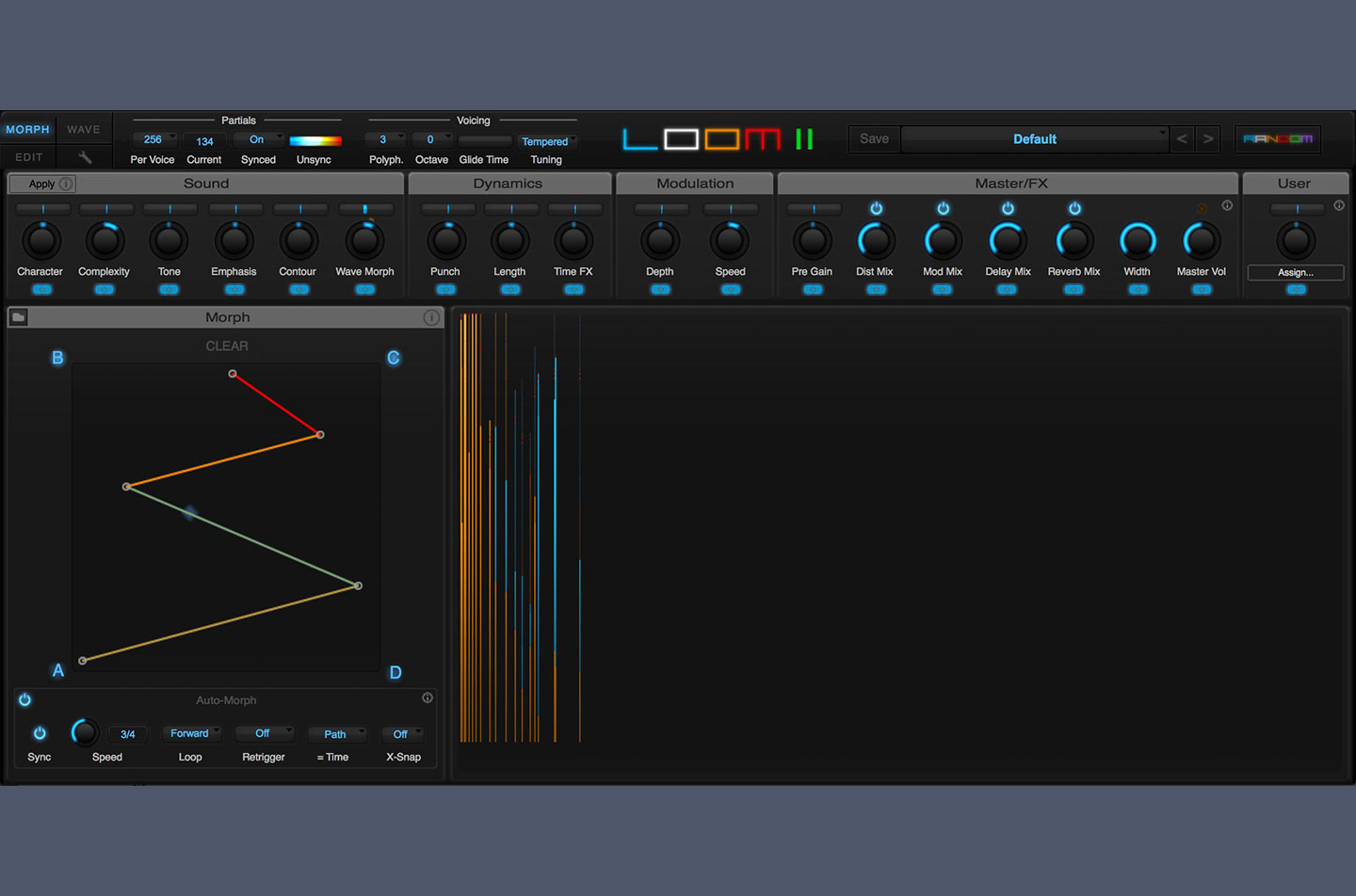- Since its release in 2013, AIR Music Technology's Loom, a modular additive synthesiser, has made an impact with its deep approach to synthesis. Its unique feature, the shape-shifting Morph Pad, and its combination of additive synthesis within a module-based interface, made it easy for users to add motion to, modulate and macro-manipulate the desired sound. Released this past October, Loom II builds on the original, adding new features that further enhance the sound-sculpting process.
Like its predecessor, Loom II has a unique approach to additive synthesis. The technique involves combining simple sinusoidal waveforms and modulating the sound using 34 editable modules. The range of possibilities for creating diverse soundscapes is endless and potentially overwhelming when you first dive in. Yet the interface is surprisingly tactile and visual, making it easy for users new to additive synthesis. It also offers more experienced producers a broad range of parameters for carefully crafting their desired sound.
For those new to Loom, you can get a good understanding of how to build your sounds by checking out the 500 new preset patches, all of which utilise the new features. There's a new Spectral Noise section, four new modules and two sub-harmonic patrials, while the Morph Pad and New Wave gain new features and parameter options.
There are three modes and pages: Edit, Morph and Wave. The Edit mode has 12 slots, ten of which can be filled by choosing from 34 editable sound generator and modifier modules. The first and last modules cannot be switched out but you can now add spectral noise and sub-harmonics to the mix. There's also the potential to distort and modulate the distribution of the frequencies among all of the partials in the first module. The last module contains the four effects, namely distortion, modulation, delay and reverb. In the ten remaining slots, user-selectable modules interact and combine to generate a patch. Each of these modules has easily editable parameters, allowing for detailed, individual control of the patch.
The modules new to Loom II are 5-Sines, Discrete Adder, Hype and Double Wave. Hype is a filter module that boosts or cuts the low or top end. When used with sub-harmonics, it fills in and adds a lot of depth to the overall sound. All of the modules can also be automated by the envelopes and LFOs at the bottom of the Edit page. 5-Sines helps simplify the sound by only allowing the first five partials to pass through, creating a more basic sine tone. Discrete Adder enhances specific partials, thickening parts of the spectrum. This module is a subtler version of the original Adder and brings out selected partials instead of the entire spectrum, which gives it a more metallic sound. Double Wave, meanwhile, is only editable on the new Wave page. This module works like the original Wave module, which acts like a vocoder, changing the levels of the partials as they pass through your own uploaded sounds. With Loom II, you can upload two separate audio files into each wave module on the Wave page. You can further texturise and modulate the sound by sculpting the parameters on either of the source waves, changing the speed, start and end times and the balance between the two.
In Morph mode, there are a variety of macro-level controls to create more detailed, individual sounds. This page also contains the Morph Pad, which adds motion and momentum. It's one of the most substantial features in the Loom series. Using the macro controls, you can assign up to four variations of a sound and save them into each of the corners, labelled A, B, C and D. The process is similar to drawing in modulation envelopes, which are then set in motion. Now you can load and save morph points and paths and effect the time a signal takes to travel down its path. Then there's a looping parameter, which sets the direction of the movement along the path.
On first impression, Loom II's sound is reminiscent of DX synthesis or Casio's phase distortion synthesis. But thanks to the amount of partials and frequencies that can be added and automated with great detail, much richer sounds can be formed. There is also a large range to the types of sounds that you can create. Because of the morphing and modulating tools, sustained pads and abstract, sound design patches really shine.
The new, enhanced version seems to focus on answering user requests, adding features that go a step further than the previous version, making what was already a deep synth more complex and tonally rich. The sub-harmonics and eight voices do make it a stronger, thicker-sounding synthesiser. But in terms of dynamics, the basic skeleton of the original Loom and its user-friendly interface remains the core behind the sound. It is only available in 64-bit VST/AU, which might be a turn off for people who still use a 32-bit DAW. If you already enjoy the original Loom, there's much to be gained from updating to the newer version. As someone who prefers hardware synthesisers and Eurorack to software, Loom II, with its variety of modes and interfaces, draws on the types of working methods I love. In addition to the endless variety of mutable parameters, it gives an intriguing pull back into the possibilities of software, and at a much cheaper price than the equivalent hardware.
Ratings:
Cost: 4.3
Versatility: 4.1
Ease of use: 3.9
Sound: 4.2
 In Morph mode, there are a variety of macro-level controls to create more detailed, individual sounds. This page also contains the Morph Pad, which adds motion and momentum. It's one of the most substantial features in the Loom series. Using the macro controls, you can assign up to four variations of a sound and save them into each of the corners, labelled A, B, C and D. The process is similar to drawing in modulation envelopes, which are then set in motion. Now you can load and save morph points and paths and effect the time a signal takes to travel down its path. Then there's a looping parameter, which sets the direction of the movement along the path. On first impression, Loom II's sound is reminiscent of DX synthesis or Casio's phase distortion synthesis. But thanks to the amount of partials and frequencies that can be added and automated with great detail, much richer sounds can be formed. There is also a large range to the types of sounds that you can create. Because of the morphing and modulating tools, sustained pads and abstract, sound design patches really shine. The new, enhanced version seems to focus on answering user requests, adding features that go a step further than the previous version, making what was already a deep synth more complex and tonally rich. The sub-harmonics and eight voices do make it a stronger, thicker-sounding synthesiser. But in terms of dynamics, the basic skeleton of the original Loom and its user-friendly interface remains the core behind the sound. It is only available in 64-bit VST/AU, which might be a turn off for people who still use a 32-bit DAW. If you already enjoy the original Loom, there's much to be gained from updating to the newer version. As someone who prefers hardware synthesisers and Eurorack to software, Loom II, with its variety of modes and interfaces, draws on the types of working methods I love. In addition to the endless variety of mutable parameters, it gives an intriguing pull back into the possibilities of software, and at a much cheaper price than the equivalent hardware. Ratings: Cost: 4.3 Versatility: 4.1 Ease of use: 3.9 Sound: 4.2
In Morph mode, there are a variety of macro-level controls to create more detailed, individual sounds. This page also contains the Morph Pad, which adds motion and momentum. It's one of the most substantial features in the Loom series. Using the macro controls, you can assign up to four variations of a sound and save them into each of the corners, labelled A, B, C and D. The process is similar to drawing in modulation envelopes, which are then set in motion. Now you can load and save morph points and paths and effect the time a signal takes to travel down its path. Then there's a looping parameter, which sets the direction of the movement along the path. On first impression, Loom II's sound is reminiscent of DX synthesis or Casio's phase distortion synthesis. But thanks to the amount of partials and frequencies that can be added and automated with great detail, much richer sounds can be formed. There is also a large range to the types of sounds that you can create. Because of the morphing and modulating tools, sustained pads and abstract, sound design patches really shine. The new, enhanced version seems to focus on answering user requests, adding features that go a step further than the previous version, making what was already a deep synth more complex and tonally rich. The sub-harmonics and eight voices do make it a stronger, thicker-sounding synthesiser. But in terms of dynamics, the basic skeleton of the original Loom and its user-friendly interface remains the core behind the sound. It is only available in 64-bit VST/AU, which might be a turn off for people who still use a 32-bit DAW. If you already enjoy the original Loom, there's much to be gained from updating to the newer version. As someone who prefers hardware synthesisers and Eurorack to software, Loom II, with its variety of modes and interfaces, draws on the types of working methods I love. In addition to the endless variety of mutable parameters, it gives an intriguing pull back into the possibilities of software, and at a much cheaper price than the equivalent hardware. Ratings: Cost: 4.3 Versatility: 4.1 Ease of use: 3.9 Sound: 4.2